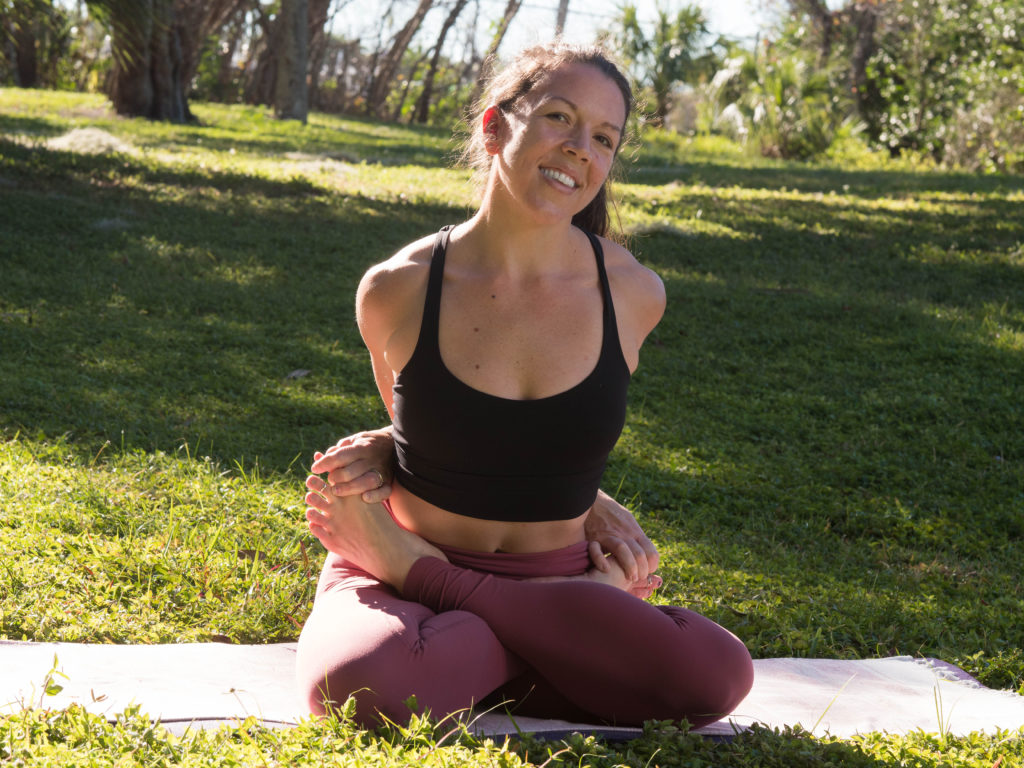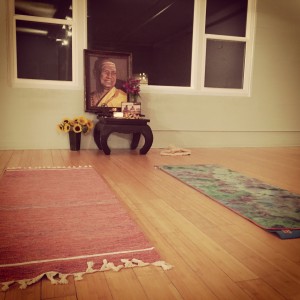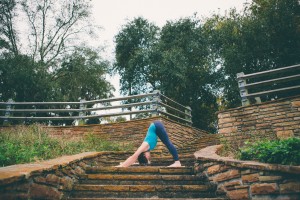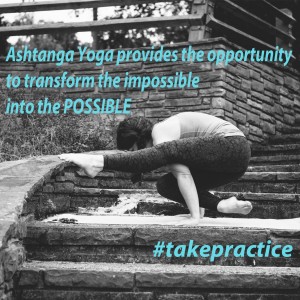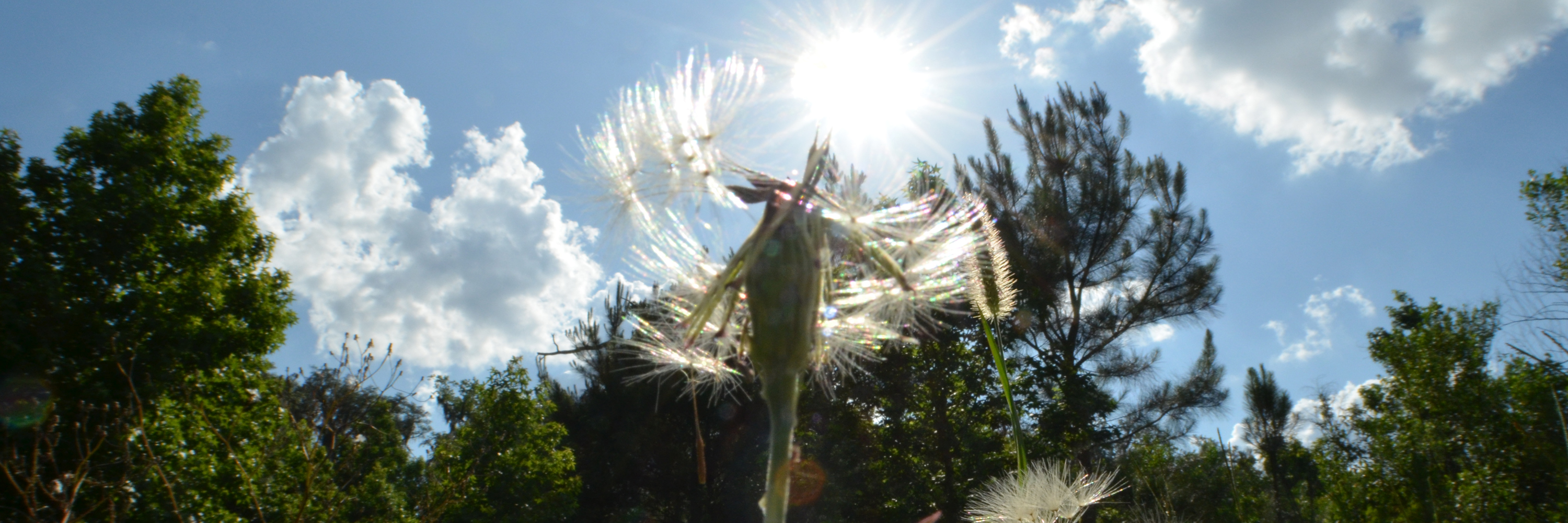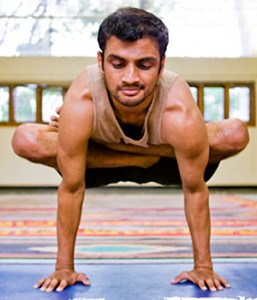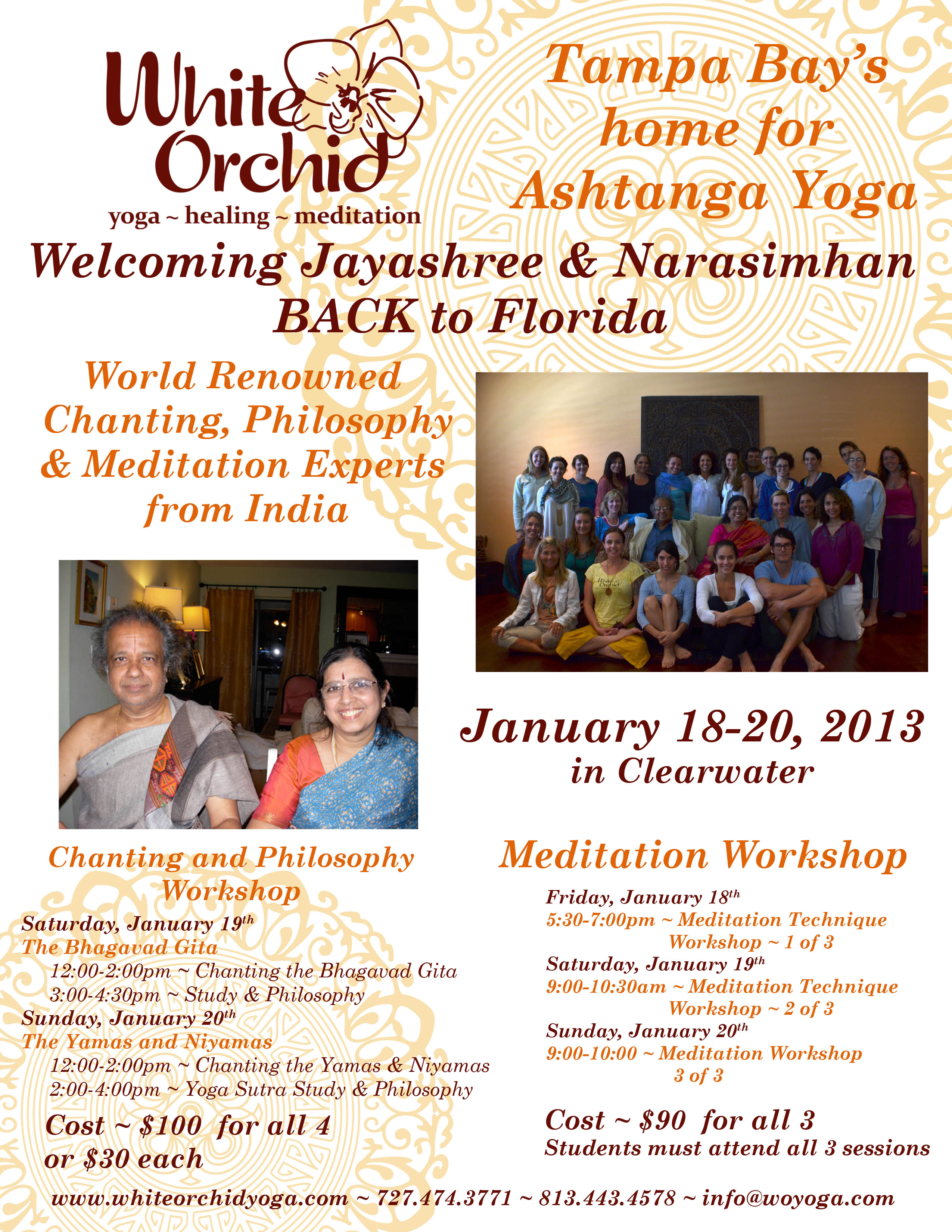Sharath Conference #3
Notes by: Sara Moncivais
Last conference we spoke about three things, asana, breathing, and concentration (drishti). These three things are very important in our practice. Why not bandhas? Uddhiyana, mula, jalandhara bandha. These three, jalandhara means locking the chin, mula is the anus, and uddiyana bandha is below the navel. That is where we lock or contract.
This mula bandha is described in Hatha yoga Pradapika and many texts. These three bhandas, especially mula bandha, is very important. Mula is the source, the base. One verse says, always mula bandha. All the time, when walking, sitting, running, when you shouldn’t do…you know that. Many people come, their first day, oh I want to know all the bhandas! Mula bandha—they don’t even know what it is. People telling, I know some senior student, they giving lecture and they don’t even know what mula bandha is, “Oh, yeah, anus contraction, yeah,” how to do that? How long it will take? What is that?
There’s so many things. The philosophy behind mula bandha no one knows. What is the philosophy behind mula bandha is, that that is the source to control the mind. There’s lots of verses which says, “If you master in mula bandha, even an old person will become young.”
This is another verse that says, “What is the source for this whole existence?” Without the air, nobody can live, fire, earth, ether, space. This fire is very important, without this nobody can survive. What is the source for this fire? I know many of you don’t want to believe in God, because it’s scary, to believe in God. Yeah, I’ve heard it so many times, “Ah, God, I don’t want, no…” So what is the source for this fire? It is the God, the Supreme Energy. This is the Supreme Soul, the Supreme Soul is the source for this fire.
How do you think this is created? There should be someone who created all these things. Created water, created air. Bringing life. This would be some energy, which is there. Energy, we can just feel it, just like yoga. Yoga you do asanas, but real yoga happens within you. Which you feel inside. So, like that is the source for the energy, the fire. What is the source? He’s just giving an example, like how I give all the time, masala dosa. So what is the source for this? To control the mind. Mula bandha is the source.
He says, “Mula bandha, he who masters it becomes the greatest yogi, the king of all the yogis.” Raja yogi means, the king of all the yogis. Many commentaries have been written on mula bandha, it doesn’t come, “Oh, I pay shala fees for one month in Mysore and I practice everyday seriously, but I didn’t find mula bandha,” It’s not possible, like that to get. It’s practice. It takes one year, two years, three years, so then you keep on practicing. Like on English man said, “Practice makes man perfect,” my wife the other day she said, “Man has to work to become perfect, but women are already perfect.”
Let’s say everyone perfect! So, how perfection comes? Only through practice. Nowadays it is all fast, fast food, you get everything fast. Everything is take away, no process to cook, or to do anything. Processing the new generation, they don’t like. Masala dosa to go. The process to make masala dosa is two days process, it’s not one day. They have to grind it, leave it the whole night, it gets fermented, long process. So yoga is also a process which should happen. Mula bandha, asanas also. To master an asana it takes time. You have to give the time, if you don’t give the time you won’t know what yoga is. So everything is mula bandha also, it takes one, two, or three years. It might take longer. Day by day when you practice you become more familiar with your asana practice. Then my grandfather always used to teach—if you go to other yoga straightaway the first day they will teach you ten, fifteen asanas straightaway. That asana, this asana, there’s no method.
Here in this state of yoga we always progress slowly, slowly, step by step. Once we master one asana then we move on to next asana. When we practice two to five years then we can realize what we are doing, until then it is just practice, more physical.
How to realize beyond your physical practice? Once we get more clarity within us, the yamas, niyamas, asana. This one subject itself, it takes forever, to learn the purpose of doing it. So many people, they get very confused. Many people who don’t have proper knowledge of yoga, you can stragihtaway know the difference—people who don’t have in-depth knowledge or experience, meaning once you do asanas for many years with devotion—it just becomes physical. Many people they don’t want to do. Asana becomes ego. Ego because you have ego, already, here what we are doing—yoga—to get rid of this thing. These people who don’t have proper understanding of yoga, you can straight away make out they don’t have experience in the system, in yoga. Straightaway—philosophy anyone can talk with a book, “Oh yeah, this is yoga,” but the in-depth experience is only through practical experience and thoughts which come in your practice, and finding answers within you and through the help of your guru. Then you get better clarity within you. Then better understanding will come. Anyone can quote sutras. Lots of translations in English—they say, “Yeah, I know,” anyone can quote sutras. My son, Sambav, can do that.
What is behind Citta Vritti Nirodah—how to do that? Have you realized that or not? You realize that, you gain Saddanah, in-depth knowledge to realize that. You do Saddanah, then only you get better understanding. Exactly for anything in yoga, as I told you, you can purchase certificate, but that won’t make you a yogi. It’s good to put on your wall and they advertise everywhere, “Yogi! Yogi John,”
Long time back I met one student, a wife of one of my friends, she said, “Oh! I am practicing yoga for four years now,” and she is asking me,” What is this? What is that?” I said, “Your teacher didn’t teach you? “ She said no, “I don’t do ashtanga yoga I do hatha yoga.” Me, “Oh OK, what is hatha yoga mean? Can you explain me?”
“Oh, don’t ask me all those things!” So in five years practicing with someone they don’t even know what hatha yoga means and she is asking all the questions to me. Unfortunately these things are happening, some people learn some asanas, they have bendy body, and they say, “I’m a yoga guru.” You see it in the paper. There’s no respect for the yoga guru, they don’t have any respect.
A guru removes all the darkness within us, all the obstacles within us, and takes us towards the brightness. Towards the jnana—the real brightness which we should have. The spiritual knowledge, removes all the ignorance in us, and takes us towards the brightness. To become a guru, this guru should have this experience for many years. This is called guru-shisha parampara. This is the lineage coming from a parampara. This is what happens when there is no parampara. (Gurus and yogi John’s everywhere, etc.) Paramprara means a teacher, a guru or master, a master, which is totally different from a teacher because their experience is in-depth on some subject. Mastering this technique, a student, devoted, the student also has some responsibilities. “Oh, I was in Mysore, I just wanted to do some yoga so I went to KPJ, I was going to Kerala, just passing Mysore, Kerala to do Pancha Karma,” He will be passing through and will never understand what yoga is.
Someone asked, “How do you recognize your guru?” A wise man asks. How to find the guru, he asks a very big master. The master says, “when you hate your guru when you see him the first time.” Then something in your mind says, “I can learn something from him,” but then something in your mind again resists. Finally, he becomes your guru.
Q&A
Q: What’s the process for developing this mula bandha?
A: There are many asanas. Now you are struggling with uth pluttihi, this is a very big tool. It’s a good tool to improve your mula bandha. Navasana, even jumping through and jumping back, one day I will show you how some people they go to handstand—this is not uth pluttihi—it doesn’t need any strength. As soon as you are mastering it is like flying, you can just jump through. It’s easy. The whole balance of your body will change once there is mula bandha, uth pluttihi is very important—it just means lift up, that’s all. Elevating your body, that’s uth plutthihi, so this one when you practice navasana try to pick up with your whole body off the floor. The feet don’t touch the floor. Once mula bandha comes uddiyana bandha will come. jalandhara bandha is mostly in pranaymana. It stops all the external air, these three bhandas will come. Right now, this things is to do, if you do mula bandha correctly you will find the other two. The source has to be strong. The foundation is not strong, then whatever comes through that will not be strong.
Q: I know of the Sutras, but I don’t know who Patanjali actually is?
A: Patanjali, there will be lots of people suffering with lots of diseases, so if Patanjali takes birth in his form with thousands of heads, people will get scared. That is why he takes form as both a human and serpent. To bring health to the people, the suffering people with diseases (physical or mental), the people are lost with delusion and confusion, lots of ignorance. He comes to preach yoga. Three things he brought is yoga for clarity, for concentration, to bring steadiness to the mind. He brought grammar, without grammar you won’t have better speech and understanding. He brought grammar. To cure diseases, he brought Ayurveda. There are two kinds of yogas— some diseases can be cured by asana practice. Some need Ayurveda.
Without grammar you won’t have better speech, without yoga you can’t have peace of mind, without Ayurveda you won’t have health—there are no side effects in Ayruveda it is all natural. Patanjali brought these three things. In the yoga sutras, yoga was before these sutras also, yoga was always there. The whole universe, the whole existence started and yoga started then. It came before Patanjali. All of this you see, the reminders start coming. Krishna he comes in the Bhagavad Gita and he teaches about yoga, Patanjali comes and he teaches about yoga. In the Bhagavad Gita it says, “Yoga is a very old knowledge and practice, which has come from a lineage, from parampara.” It has come from one generation, guru, to another, student.
There is no time when yoga started. It’s timeless. Why is it timeless? Because yoga can’t be seen, it can only be experienced. You can see me, as soon as I took birth. Yoga is all the experience, which happens within you, if you do in the proper direction with the proper ingredients. If you want to plant a rose plant you have to nourish the earth, the soil, you have to give many things.
If you nourish that soil, then automatically a flower will blossom. If you don’t, the plant will die. Is it not true? You don’t water it or nourish it and it will die. Like that, our body is here and our mind is there. What is the nourishment we have to give for the yoga to happen? Yoga is the flower that blossoms within you. What to do for yoga to blossom? We have to follow yama, niyamas, asana, pranayama. Yamas and Niyamas are very important in our practice, these are the nourishment. Then the yoga will happen. The first four limbs are external exercises. Now I’m doing Dhyana. You can’t say that. Some people want more attention, “Oh yeah, I went to this lady she was doing dhyana!” If you are in the state of dhyana nobody will realize, it happens within you! You can’t advertise, it happens within you! When you are in this state you get absorbed in the deepest meditation, all of your sense organs come together and you go to that deepest state of yoga. Meditation can be focused, drishti can be meditation, that’s all. Dhyana is where you withdraw all your sense organs and everything becomes one. Everything becomes one and you don’t know where you are, then everything becomes clear.
There’s no you and then that thing, everything becomes one. That is again, yoga. Yoga can be described as many things. Self-realization is the perfect word for yoga. Transformation happens when self-realization happens. Transformation happens when you follow yama and niyamas. It becomes clearer, day-by-day and year-by-year as you practice. If the transformation does not happen you are doing something wrong, you are making some mistakes.
Q: Why do injuries happen?
A: There’s lots of reasons. Overdoing it is easy to injure yourself, you do it here and you go home and do it again. You’re doing asana practice you just have to concentrate on asana practice. You can’t go and do bicycling for two hours and then come and do asanas. These are opposite things. When you’re doing asana you don’t need to do anything else. Your body is getting stiffer cycling. Here you are coming and getting flexible. When your body is getting stiff and flexible, stiff and flexible, then you are easy to hurt yourself. Everything in asana practice is opening.
I played lots of cricket when I was young, so when I came back to yoga I could feel that there was so much difference between cricket and yoga. I didn’t play after that. I had to go through so many pains in the practice. When you are getting flexible also you get pain in the body, so many changes. If you go to bad teacher, it is possible to get injured.
You have to allow your body to change. You see someone else doing a pose and oh you want to do!! Then you do and don’t give time for your body to change, then you hurt yourself. You should understand how to use the asanas. You can’t do all the asanas and you have to give time. The more time you give, the more you can perfect. You want perfection or you want to learn 100 asanas without any perfection? I would rather do ten asanas or twenty with perfection.
There’s lots of changes to happen in your body. This process should happen. Sometimes you get pain and it quickly goes away, sometimes you get pain and it doesn’t go away for years.
Once in 93/94, guruji taught me a deep back bending and I wanted to go deeper and deeper. It was eka pada raja kapotasana, you bring the leg behind you and catch the ankle with both hands, I was already deep—my heel was here (he points to his nose)—and I thought, “Oh, I can go deeper,” so I pulled and heard a tear here. I couldn’t lift my hand. The morning it happened, I came home, I could take deep breath, in the evening an institution came and wanted us to give demo. My grandfather said, “Yeah, tomorrow we will give, no problem,” I said, “Who is doing the demo? I’m injured, I can’t lift my hand or breath.” There was no one to do the demo, I had to do the demo. I don’t know how I did, but I did kapotasana. After that for one month I couldn’t move my body—even Surya Namaskara was hard! Sometimes we don’t put enough attention in asana practice. The attention should only be in asana practice, when your mind gets distracted, you’re physically here but your mind is somewhere else, many times you get injured like this.
The whole attention should be on your practice. It’s a kind of meditation also, which you learn and it automatically becomes a meditative practice. All of your attention is towards, “Oh what’s he doing? Oh she’s doing kapotasna,” then you go have coffee and discuss all the asanas. Concentrate on your practice. Put everything into your practice. Do that for one week, two weeks, two months and your practice becomes a meditative practice. You do that and your practice will change, you can feel this is not just physical exercise, but a spiritual practice. So many changes will happen within you when this happens.
I’ve done so many demonstrations. 5,000 or 6,000 people I have seen at demonstrations. As soon as I go to my postures I don’t know what happens around me. I’m not worried about how I can perform the asanas. It took many years of practice like that. Getting up at 1 o’clock everyday and practicing 2 or 3 hours I have developed that. As soon as I come to yoga practice my attention comes to my practice. This is what you have to develop within you. Once you develop that you can go to another level of yoga. You can straightaway experience something different.
Q: 99% of practice is not just for the practice, the yamas and niyamas also.
A: Guruji taught 99% practice but people didn’t understand what he was telling. Guruji’s English was very limited, but he learned so much over the years. Later on he became more fluent, but 99% practice many people think, “I have to do asanas here, I have to go home and do asanas, I have to do asanas there.” 99% practice, they didn’t have proper understanding what it was. The real experience only comes when we practice and we realize what it is.

